Sonos BU150 Wireless Digital Music System Review
Sonos BU150 Wireless Digital Music System
If you want to stream your digital music to any and every room in your house, you want a Sonos system.
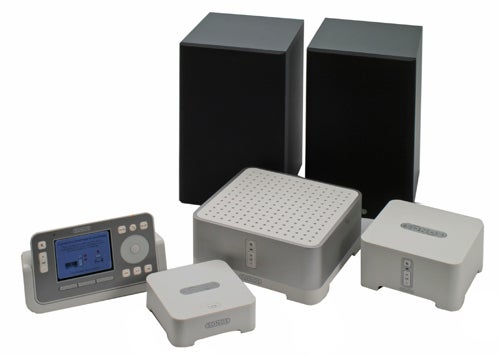
Verdict
Key Specifications
- Review Price: £699.00
It was back in 2006 when I first played with a Sonos system, and I was pretty damned impressed. The problem with most music streaming devices at the time was that they came from networking manufacturers who knew a lot about the technical side, but weren’t so clued up when it came to the user experience. As such, you ended up with devices that “kind of” worked, if you knew what you were doing, and if you had a decent enough home network in the first place. Sonos, on the other hand, came at the problem from the other side, deciding to build a supremely usable device that was then stuffed full of digital streaming goodness, over both wired and wireless networks.
Despite the fact that Sonos managed to hit the usability nail right on the head, there were a couple of negative points with the system, the most notable being the high purchase cost. Added to the initial cost of the system, there was also the added expense of “wasting” a ZonePlayer, just to get you connected to your home network. You see, the first ZonePlayer in the system had to be hard wired to your router, and then the others could all communicate wirelessly. Unfortunately this meant that if your router wasn’t in a convenient place (mine’s sitting next to my sofa, because that’s where the phone line is), the ZonePlayer that you had to use to get connected, couldn’t then be used for music, thus making it a very expensive wireless bridge. Thankfully, Sonos has addressed both of those issues, and with the new BU150 bundle, kitting your house out with a Sonos system has never been more affordable.
”’(centre)The speakers, ZoneBridge and docking cradle are optional extras, but the latter is definitely worth buying.(/centre)”’
Although the components that make up the new Sonos BU150 bundle look familiar, with the exception of the superb remote handset, everything has changed. When Jon tested the Sonos ZP80 bundle back in 2006, there were two types of ZonePlayers, the aforementioned ZP80 and the ZP100 which featured an integrated amplifier. This latest bundle however, features the new ZP90 and ZP120 ZonePlayers, and we’re talking more than just semantics here. It’s also worth mentioning that back in 2006 the basic bundle consisted of two ZP80 ZonePlayers and the remote handset for £779, while the new BU150 bundle gives you one ZP90 and one ZP120, plus the remote handset for only £699!
One of the things that always made Sonos systems so easy to setup, is that they incorporated their own wireless mesh system, rather than trying to piggyback off your home Wi-Fi network. This meant that there were no wireless channels to worry about, no MAC address filtering to contend with and no encryption keys to enter – it really was a plug and play system. These latest ZonePlayers move the game on by using the new SonosNet 2.0 standard, which brings with it both AES encryption, and more importantly, MiMo technology. Now we’ve seen MiMo (Multiple in Multiple out) technology used in wireless devices for a while now, and it’s also an intrinsic part of the new 802.11n standard. By including MiMo in its ZonePlayers, Sonos is essentially extending the range of the devices, by allowing multiple signals to be sent and received.
While I’m talking about networking, it’s also worth remembering that Sonos has always been clever with its wireless implementation, by creating a mesh network in your home. This means that each ZonePlayer you add to your home acts as a wireless repeater for all the others, thus extending the wireless range. I tested the merits of the mesh networking when I installed the system in my house. Having recently had an extension built, it allowed me to place the ZP120 at the opposite end of the house from my router. I also placed the ZP120 in a closed AV cabinet, surrounded by various gaming consoles, HD players and my Sky box – a fairly hostile environment for any wireless device. With the cabinet door closed, the wireless connection to the ZP120 was fairly flaky at best, and just about usable once the door was open. However, when I setup the ZP90 in my dining room, which sits mid point through the house, the ZP120 had no problem connecting wirelessly – basically I’d halved the distance that the wireless signal had to travel, since the ZP90 acted as a repeater.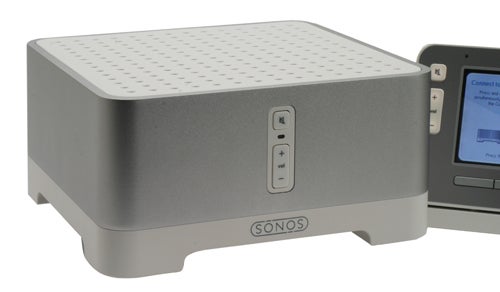
One thing that you don’t get in the BU150 bundle is a ZoneBridge. This little box of tricks allows you to connect up to your home network, without having to waste a ZonePlayer – it will set you back an extra £69, but considering the ZP90 costs £249, it’s a far more cost effective solution if your router/switch isn’t in a convenient place. That said, Sonos has done the right thing by not bundling the ZoneBridge, because if you did have your router near your Hi-Fi, you could use the ZP90 to connect up to the network and stream music.
I’m still slightly stunned by how easy it is to setup and use a Sonos system, especially considering the amount of technology that’s squeezed into each box. Even a novice user should be up and running in less than an hour – in fact the most time consuming part is deciding where you want to place each ZonePlayer, and how many rooms in your house you’d like filled with music. The Sonos Desktop software disc is both Windows and Mac compatible – a smart move, considering that most Mac users tend to have pretty extensive iTunes libraries. 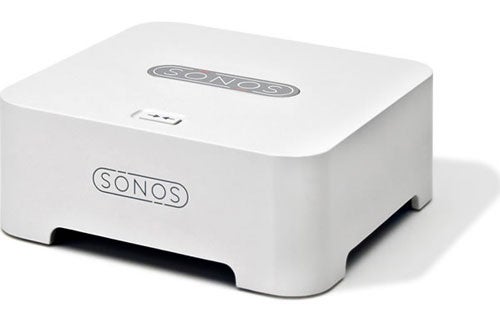
”’(centre)The ZoneBridge will get you connected without wasting a ZonePlayer – it will cost you extra though.(/centre)”’
Once you’ve setup all your ZonePlayers, you can just point your Sonos system at any folders on your network that contain music, whether on a PC or a NAS appliance, which is where I keep all my music. If you’re an iPod user and you have a NAS appliance, you’ll probably be using the latter as an iTunes server like me, but even if your network storage doesn’t support iTunes, it doesn’t matter, because Sonos needs nothing more than a folder path to access all your stored music. And if you drop more music into the folder, it’s a simple one button update from either the desktop application or the remote handset to bring the Sonos library into line.
In my house I use a mixture of Wi-Fi and HomePlug for my devices, and where my AV kit is setup, I have an Ethernet switch, that’s connected to a HomePlug module. This allows me to connect my PS3, Xbox 360 and HD DVD player (yes I still have one) without resorting to wireless. So when it came to hooking up the ZP120, I had the option of just connecting it to the switch via Ethernet.
Despite the fact that the ZonePlayers are undoubtedly cool, it’s the remote handset that really steals the show. Although the controller is essentially the same as it was two years ago, it’s no less impressive to use, and just goes to show how far ahead of the competition Sonos was back then. Sonos has, unashamedly aped the iPod scroll wheel, but that’s no bad thing. When you’re having to navigate through a massive music library, there is no better tool out there. Just like on an iPod, you can rotate the wheel clockwise or anticlockwise, then press the button in the centre to make selections – it’s quick, it’s simple, it works!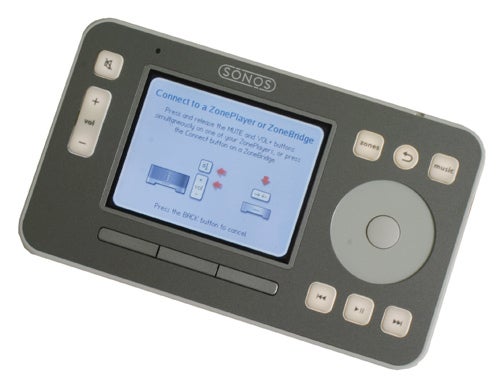
Below the wheel are play/pause and skip forward/backward buttons. While above the wheel is a Music button, that jumps you straight back to the music menu from anywhere, a Back button and the all important Zones button. Hitting the Zones button brings up a list of all your configured zones – Living Room and Dining Room in my case, but of course your zones could be anywhere and far more numerous. Simply select a zone, and then you can control all the music in that particular room – want to turn the music on in your bathroom while you’re in the kitchen? No problem.
The controller is dominated by the 3.5in colour screen, which displays all the menus as well as cover art for the music you’re listening to. The screen is transflective, so it’s easy to read even in bright sunlight, which is important if you want to control your music while you’re having a barbecue on the patio. To the left of the screen you’ll find volume controls and a Mute button – pressing the Mute button for three seconds will mute all the zones on the system, another nice touch. Finally, below the screen are three soft buttons – these are context dependant and will do different things depending on which menu you happen to be in and what you’re doing.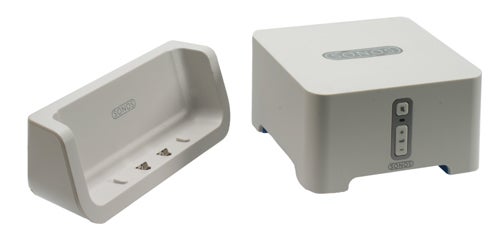
”’(centre)The charging cradle is an optional extra, but it’s definitely worth the extra cash.(/centre)”’
It’s always good to see backlit buttons on a remote control, making it easy to use with the lights dimmed, and the motion sensor is a stroke of genius. While the controller is lying dormant, it will switch the screen and buttons off, but the minute you pick it up, it will spring to life, without you having to touch a thing. It’s also definitely worth investing in the optional charging cradle for the controller – it’s a far more elegant solution than having to plug a cable into the top of the device to keep it juiced up.
File format support is very, very good – you get MP3, WMA, AAC. Audible (Format 4) and impressively, Ogg Vorbis lossy standards. And if you’re serious about your audio quality, you’ll be glad to hear that there’s support for Apple Lossless and Flac, while uncompressed WAV and AIFF files will also play.
Pretty much everything Jon said about sound quality in his original review stands. How good a Sonos setup sounds will depend on a variety of factors. First and foremost, audio quality will depend on how your music is encoded – which codec you choose and the bit rate at which you encode. If you have enough disk space, using a lossless codec like Flac will take this step of the process out of the equation. 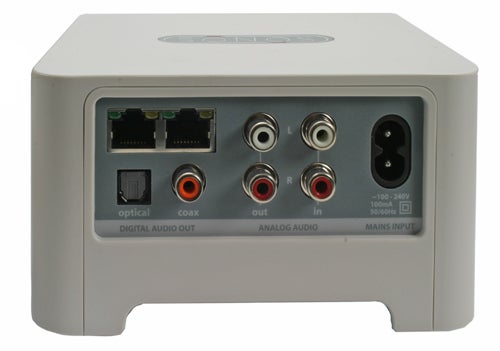
”’(centre)The rear panel of a ZonePlayer 90.(/centre)”’
The second limiting factor will be the DACs inside the ZonePlayers, and although a serious audiophile like Jon will never be happy with the sound that the Sonos DACs produce, I honestly feel that the vast majority of consumers will be more than happy with the job done by the ZonePlayers in this department. Also, as with the ZP80, the ZP90 ZonePlayer features digital audio outputs in both optical and coaxial formats. This means that you can output the music as a digital bit stream, and use an external DAC – this way, an audiophile can stream losslessly encoded music around their house, while enjoying high quality playback through their own Hi-Fi equipment.
The ZP120 doesn’t have digital audio out, because it’s supposed to be used as a standalone Hi-Fi, a job which it does quite well. Again, true Hi-Fi buffs will probably be disappointed by the combination of Sonos’ DAC and amp, but the overall effect is far from offensive, and once more I doubt that most consumers would be disappointed in any way. Sonos sent me a pair of its own speakers to test with, which add an additional £130 to the price of the BU150 bundle, and although they produce reasonable sound, I’d suggest spending a little more on a better set, even if you’re connecting them to the ZP120. You can pickup some great bookshelf speakers from the likes of Kef for only a little extra.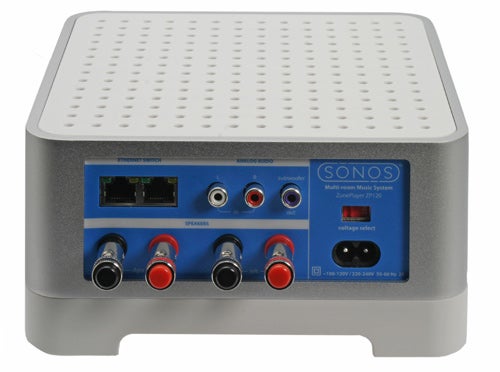
”’(centre)The rear panel of a ZonePlayer 120.(/centre)”’
The ZP120 is a far smaller device than the ZP100 that it replaces, despite packing the same 55 Watt output as its predecessor. The one compromise that has been made due to the reduced size, is the number of ports on the built-in Ethernet switch. Whereas the ZP100 sported a four-port switch, the ZP120 only has two ports, just like the ZP90 in fact. The Ethernet ports add to the flexibility of the system, allowing you to connect directly to your network if that’s convenient, while also allowing you to piggyback other devices on the Sonos wireless mesh. Let’s say for instance, your ZonePlayer 90 was sitting next to your Xbox 360 – you could get your Xbox online, by connecting it to the ZP90 via Ethernet, without having to buy a separate wireless module for it.
The controller isn’t completely perfect though. Despite the fact that the scroll wheel works brilliantly for navigating long lists, a touch screen would definitely aid usability. When you want to search for a particular artist or album, having to scroll backwards and forwards through the alphabet using the wheel is laborious. Stabbing at each letter with your finger would be a far quicker and easier solution, although I appreciate that a touch screen would add cost to an already expensive device.
If you have a very large house, with a lot of zones, you’ll probably have multiple people listening simultaneously, which could lead to a fight for the controller. Luckily, this is where the aforementioned Desktop Controller software comes in, which allows you all the same control from a computer. So, if you happen to be working in the study, you can control your own music without the need for the remote handset.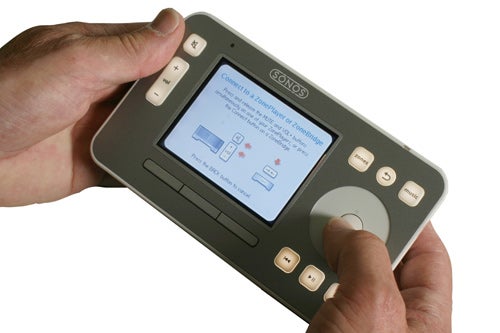
Having access to your own music library from anywhere in your house is definitely impressive, but you can also gain access to a plethora of music that you don’t own too. The Sonos system supports the Napster music service, which means that once you sign up for a Napster account, you can playback any of the six million tracks provided by the service. This means you’ll have access to music and even whole genres that may not reside in your collection, giving you the opportunity to broaden your musical horizons – I know that sounds a bit pretentious, but you get my drift.
You get a free 30 day Napster trial when you purchase a Sonos system, which will give you plenty of time to appreciate the merits of having so much music at your disposal. After the trial is over, a Napster subscription will cost you £9.99 per month, which is a small price to pay considering what you’re getting – can you really not forego a few coffees from Starbucks every month to massively increase your music library? Of course people who oppose subscription music services will complain about how once you cancel your subscription, you can’t listen to the music anymore, but I can’t understand why that’s an issue. After all, if I cancel my Sky subscription tomorrow, I can’t watch Sky Movies anymore – what’s the difference?
It’s also worth remembering that if you do choose to subscribe to Napster, you won’t be limited to listening to the music on your Sonos setup, you’ll also be able to stream tracks to any PC that’s connected to the Internet. This essentially means that you could have access to all that music at work too – assuming that you’re allowed to install software on your work PC of course.
As enthusiastic as I am about services like Napster, it’s worth noting that if you’re concerned with audio quality, you should think of Napster as an auditioning tool. A service that allows you to listen to an album at your leisure for a while before you decide whether or not to buy the CD. You see, even if you download music from Napster, the vast majority of it will be encoded at 192kbps, which many will consider too low, especially if you’ve gone to the trouble of ripping your whole CD collection in Flac (yes I’m talking about you Jon). But even that caveat doesn’t change the fact that the addition of Napster support to the Sonos party is a definite bonus.
However, while I’m talking about music services, I should probably mention another potential issue. If you’re one of those strange people who insists on buying DRM encoded tracks from the iTunes store, a Sonos system will not be able to play those tracks, since Apple is far from liberal when it comes to licensing its DRM technology. Personally I don’t see this as a problem, since I have no idea why anyone would buy compressed music from iTunes, when the proper CD can usually be had for roughly the same price, giving you the uncompressed music and the opportunity to make a compressed copy yourself. That said, I’m sure that there are many, many people out there with a library full of DRM music purchased from iTunes, and this could be a major consideration for them.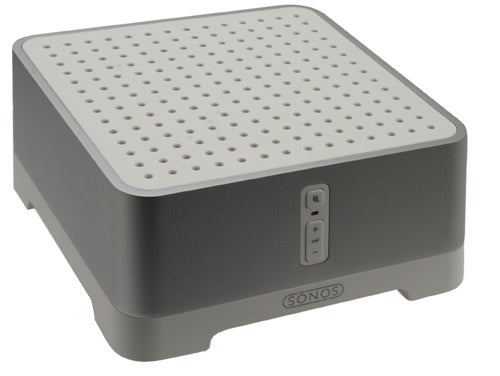
Oh, and I almost forgot that the Sonos system will let you stream Internet radio stations too, so if you happen to be in an area of poor broadcast reception, you can be sure you never miss your favourite show. Not to mention the fact that if you have a penchant for a particular foreign radio station, you’ll be able to listen to that all over the house – assuming it streams its content of course.
Finally, if you find yourself in the mood for a house party, a Sonos setup will let you pump the same music to multiple rooms, to keep the party going all over the house. Of course playing different tracks in different zones is also possible, but syncing the same track in multiple locations is another impressive feat.
The BU150 bundle may look expensive at £699, but it really isn’t. What you’re getting is a superb, easy to setup, easy to use and brilliantly implemented wireless digital music system. But before you whip your credit card out, let’s not forget that you’re going to need a decent set of speakers to go with the ZP120, and already have a Hi-Fi to connect the ZP90 to. Realistically, you’re probably looking at closer to a grand to get the very best out of a Sonos system – that will let you buy a great pair of speakers, a ZoneBridge and a docking cradle for the controller. And even when the purchase price is pushing four figures, I still can’t help but think it’s worth it.
”’Verdict”’
Two years ago Sonos had the best digital music solution out there, and two years later nothing has changed. Yes, there are other products on the market that can do some of what the Sonos can do, but there’s nothing short of a full professional install that can really compete with this. If you’re looking for the most versatile way to listen to digital music anywhere in your home, you better start saving for a BU150.
Trusted Score
Score in detail
-
Value 8
-
Features 9
-
Design 9

